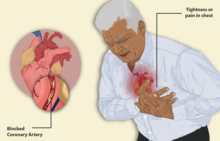
Back Angina pectoris AF Angina pectoris AN ذبحة صدرية Arabic Stenokardiya AZ Стэнакардыя BE Ангина пекторис Bulgarian হৃৎশূল Bengali/Bangla Angina pectoris BS Angina de pit Catalan Angina pectoris Czech
| Angina | |
|---|---|
| Other names | Stenocardia, angina pectoris |
 | |
| Illustration depicting angina | |
| Pronunciation | |
| Specialty | Cardiology |
| Complications | Myocardial infarction, unstable angina |
Angina, also known as angina pectoris, is chest pain or pressure, usually caused by insufficient blood flow to the heart muscle (myocardium).[2] It is most commonly a symptom of coronary artery disease.[2]
Angina is typically the result of partial obstruction or spasm of the arteries that supply blood to the heart muscle.[3] The main mechanism of coronary artery obstruction is atherosclerosis as part of coronary artery disease. Other causes of angina include abnormal heart rhythms, heart failure and, less commonly, anemia.[4] The term derives from Latin angere 'to strangle' and pectus 'chest', and can therefore be translated as "a strangling feeling in the chest".
An urgent medical assessment is suggested to rule out serious medical conditions.[5] There is a relationship between severity of angina and degree of oxygen deprivation in the heart muscle. However, the severity of angina does not always match the degree of oxygen deprivation to the heart or the risk of a heart attack (myocardial infarction). Some people may experience severe pain even though there is little risk of a heart attack whilst others may have a heart attack and experience little or no pain.[6][7] In some cases, angina can be quite severe. Worsening angina attacks, sudden-onset angina at rest, and angina lasting more than 15 minutes are symptoms of unstable angina (usually grouped with similar conditions as the acute coronary syndrome). As these may precede a heart attack, they require urgent medical attention and are, in general, treated similarly to heart attacks.[8]
In the early 20th century, severe angina was seen as a sign of impending death.[9] However, modern medical therapies have improved the outlook substantially. Middle-age patients who experience moderate to severe angina (grading by classes II, III, and IV) have a five-year survival rate of approximately 92%.[10]
- ^ "The definition of angina".
- ^ a b "Coronary Heart Disease, Myocardial Infarction, and Stroke — A Public Health Issue | CDC". www.cdc.gov. 31 July 2019. Retrieved 16 January 2022.
- ^ Dorland's Illustrated Medical Dictionary. Philadelphia, PA: Saunders. 2003. p. 82. ISBN 0-7216-0146-4. Retrieved 24 August 2022.
- ^ Perera, Chanaka Aravinda, Biggers, Richard Peters, Robertson, Alan (1 August 2019). "Deceitful red-flag: angina secondary to iron deficiency anaemia as a presenting complaint for underlying malignancy". BMJ Case Reports. 12 (7): e229942. doi:10.1136/bcr-2019-229942. PMC 6677945. PMID 31371333.
- ^ "Angina". Heart and Stroke Foundation of Canada. Retrieved 2024-11-26.
- ^ Björck, Lena, Nielsen, Susanne, Jernberg, Tomas, Zverkova-Sandström, Tatiana, Giang, Kok Wai, Rosengren, Annika (26 November 2018). "Absence of chest pain and long-term mortality in patients with acute myocardial infarction". Open Heart. 5 (2): e000909. doi:10.1136/openhrt-2018-000909. PMC 6269644. PMID 30564376. Retrieved 27 August 2022.
- ^ Canto, John G., Goldberg, Robert J., Hand, Mary M. (10 December 2007). "Symptom Presentation of Women With Acute Coronary Syndromes: Myth vs Reality". Archives of Internal Medicine. 167 (22): 2405–2413. doi:10.1001/archinte.167.22.2405. PMID 18071161. Archived from the original on 2022-08-27. Retrieved 27 August 2022.
- ^ American Heart Association (8 November 2021). "Angina (Chest Pain)". American Heart Association. Archived from the original on 27 August 2022. Retrieved 27 August 2022.
- ^ White PD (1931). Heart Disease (1st ed.). Macmillan.
- ^ Boden WE, O'Rourke RA, Teo KK, Hartigan PM, Maron DJ, Kostuk WJ, et al. (April 2007). "Optimal medical therapy with or without PCI for stable coronary disease". The New England Journal of Medicine. 356 (15): 1503–16. doi:10.1056/NEJMoa070829. PMID 17387127.